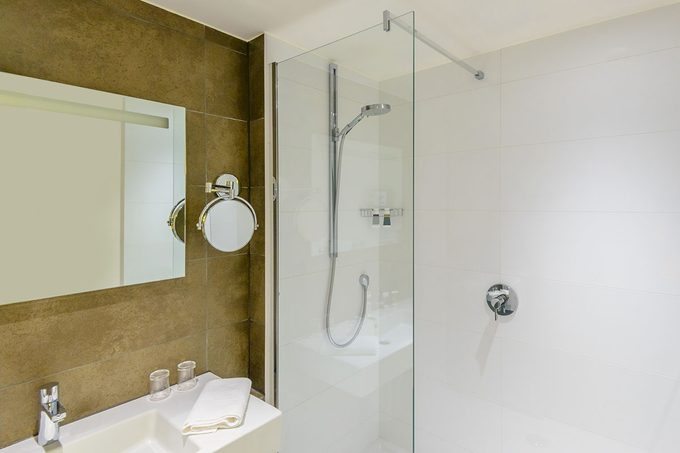The reason behind the design choice that launched a thousand soggy bath mats

Here’s Why So Many Hotel Showers Have Just Half a Door

You step into your hotel shower and notice something’s missing—namely, half the door. What starts off feeling chic can quickly turn into a wet-floor hopscotch situation. And those who like their showers steamy may find themselves doing the keep-away-the-draft dance.
Still, this half-glass look is showing up in hotels of all kinds, from boutique to big brand. So what gives? It’s not just about looks—it’s a calculated (and surprisingly clever) choice. Read on to find out what’s going on with these mysterious half-doors.
Get Reader’s Digest’s Read Up newsletter for more common curiosities, travel, humor, tech, cleaning and fun facts all week long.
When did this half-door trend start?
There’s some debate over where the half-glass shower door trend got its start. Some point to Japan, where minimalist, spa-inspired design is the norm. Others trace it back to Europe in the 1980s—and that’s where certified kitchen and bath designer Dondi Szombatfalvy places her bet.
“Europe is still ahead of the curve when it comes to bathroom design,” she says. “Trade shows like EuroCucina in Milan are where you see the boldest ideas first. That’s where this look really gained traction.”
The style trickled into boutique U.S. hotels about a decade ago and has slowly made its way into mainstream hospitality and even some homes.
Why do so many hotel showers have half-doors?

As we mentioned, this isn’t random. Here are the reasons for this increasingly popular choice:
Ease of cleaning
Unlike curtains, which can trap mildew and have to be replaced constantly, a stationary glass panel is easier to clean. And that’s not all: Without hinges or rollers, it has fewer parts and crevices where soap scum can hide. “No tracks, no grooves,” says Szombatfalvy. “It’s easier for housekeeping and more hygienic overall.”
Lower costs
Just one clean slab of glass can also help a hotel cut costs. “Hotels love the reduced maintenance,” Szombatfalvy says. “Fewer moving parts mean fewer things to fix.”
Aesthetics
Of course, looks matter too. The simplicity of a frameless glass panel has a Euro sleekness. It instantly elevates the room, especially when paired with trendy rain showers (which point straight down and are less likely to spray out). It also makes the bathroom feel bigger, which is a major plus in tight city hotels.
Are half-doors actually functional?
Functionality depends on how the entire bathroom is designed. A properly pitched tile floor can handle some splash. But if not? Guests get a soggy floor—and Reddit has plenty to say about it. One user wrote, “Warm face, cold butt … HATE them! Let’s not even begin to talk about the amount of water that ends up on the floor!” Another said: “Why am I tasked with managing water containment on vacation?”
Szombatfalvy gets it. “It’s not perfect,” she admits. “You often have to step into the cold shower to turn it on unless the controls are relocated. That’s a common guest complaint.”
Are more hotels moving in this direction?
This trend started in boutique hotels, but half-glass panels have now been spotted in mid-range hotels too. That said, budget chains often stick to tried-and-true curtains. “They’re cheaper,” Szombatfalvy says, “and people are familiar with them.”
Often, budget hotels go with the most affordable option, which are tub-shower all-in-one-units. Curtains are typically the only way to go with these, as adding glass doors would be cost prohibitive.
What’s next in hotel showers?
As bathroom tech evolves, look out for digital controls (think: push-button temperature settings) and zero-threshold showers—no curb, just one seamless floor. Wet rooms are also on the rise: These all-tile spaces can get completely soaked without issue, because they are pitched to make the water drain discreetly. “They cost more upfront, but they last longer and feel truly luxurious,” says Szombatfalvy.
So while the half-glass door may never win universal love, it’s a design compromise: sleeker than a curtain, cheaper than a full enclosure and just splashy enough to spark debate. Bring flip-flops.
RELATED:
- Here’s Why Making This One Request Is Essential When Checking In to a Hotel
- Hotels Are Pushing a New Way to Tip—And Guests Have Strong Opinions About It
- Here’s Why You Should Always Put Your Toothbrush in Your Hotel Room Safe (Yes, You Read That Right!)
About the expert
|
Why trust us
At Reader’s Digest, we’re committed to producing high-quality content by writers with expertise and experience in their field in consultation with relevant, qualified experts. We rely on reputable primary sources, including government and professional organizations and academic institutions as well as our writers’ personal experiences where appropriate. We verify all facts and data, back them with credible sourcing and revisit them over time to ensure they remain accurate and up to date. Read more about our team, our contributors and our editorial policies.
Sources:
- Dondi Szombatfalvy, certified kitchen and bath designer and certified living-in-place professional at Sims Exteriors & Remodeling; interviewed, June 2025
- Explore: “One Unusual Detail About Hotel Showers in Europe Tourists Should Know Before Visiting”
- Forbes: “The Great Disappearing Act of The Hotel Shower Door”
- Reddit: “Half-Glass Showers w/ No Door”



